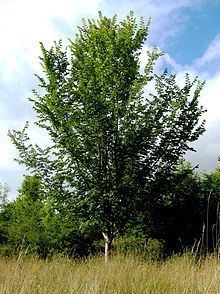Cultivar 'Nanguen' = Lutece™ | ||
 | ||
Hybrid parentage 'Plantyn' × ('Bea Schwarz' × 'Bea Schwarz' selfed) Origin Wageningen, The Netherlands Similar Ulmus 'Wanoux' = Vada, Ulmus 'San Zanobi', Ulmus 'Plinio', Ulmus 'Plantyn', Ulmus 'Morfeo' | ||
Ulmus 'Nanguen' (selling name Lutèce) is a complex fourth generation hybrid cultivar from the cross 'Plantyn' × ('Bea Schwarz' selfed), an ancestry comprising four field elms (U. minor), a wych elm (U. glabra), the curious Exeter Elm ('Exoniensis'), and a frost-resistant selection of the Himalayan elm (U. wallichiana).
Contents
- Description
- Pests and diseases
- Cultivation
- Conservation role
- Etymology
- Europe
- North America
- Nurseries
- Pictures
- References
Originally identified as clone 812, Lutèce was not promoted by the Dutch owing to unfounded fears that it may prove susceptible to coral spot fungus (Nectria cinnabarina). Instead, '812' was acquired by the French Institut National de la Recherche Agronomique (INRA), which subjected the tree to 20 years of field trials in the Bois de Vincennes, Paris, before patenting and release in 2002 as 'Nanguen' = Lutèce.
Lutèce was introduced to the UK by the Hampshire & Isle of Wight Branch, Butterfly Conservation, in 2002, as part of its assessment of DED-resistant cultivars as potential hosts of the endangered White-letter Hairstreak.
Description
The stem of Lutèce typically forks at a height of 1–2 m, where 3–5 steeply ascending branches develop in conjunction with more obtusely angled lower side branches to form an amorphous open crown. The ultimate size and shape of this cultivar remains unknown but, given its ancestry, it should reach at least 30 m in height. The trees planted in the Bois de Vincennes attained an average height of 12.5 m with a trunk diameter of 22 cm at 20 years of age. Quick growing on moist, well-drained soils, increasing in height by an average of 80 cm per annum, the tree commences flowering in late March when aged seven years. The leaves are elliptic to orbicular < 11 cm long × 9 cm wide, the acuminate apex far less pronounced than in most other elms, with coarse, doubly serrate margins; the upper surface is rough. The leaves flush relatively late, rarely before mid-May in England. The samarae are obovate, slightly notched at the outer end, 14–22 mm long by 11–17 mm broad. The seed is not central but slightly nearer the notch, and ripens in late May. The tree commonly suckers from the roots.
Pests and diseases
Lutèce exhibited a high resistance to Dutch elm disease when inoculated with unnaturally high doses of the causal fungus Ophiostoma novo-ulmi, and was rated 5 out of 5 in Dutch tests. Tests in France by INRA confirmed the tree has 'highly resistant'. In trials conducted by the Istituto per la Protezione delle Piante, Florence, Lutèce suffered 19.8% defoliation and 11.7% dieback when inoculated, compared with 2.8% and 1.2% resp. for 'Sapporo Autumn Gold', and 50% and 35.5% resp. for 'Lobel'.[6]
The presence of U. wallichiana in the ancestry of Lutèce poses the risk of susceptibility to elm yellows (phloem necrosis), which seriously damaged its Dutch stablemate 'Lobel' used as a control in the Italian elm breeding programme.
Cultivation
The cultivar is now being widely planted in cities, notably Paris, and rural areas of France. In trials in southern England, the tree has proven very hardy, tolerant of sea winds, summer droughts, and ground waterlogged during winter. However, top-growth can often outpace root development, leaving some trees susceptible to wind-rock when young and necessitating staking for up to six years. Lutèce is cold hardy, and has survived winter temperatures as low as - 30° C at Julita in Sweden. Lutèce was introduced to North America in 2010, with the supply of two small specimens to the USDA, Washington, D.C., released from quarantine in 2013. Lutèce is not known to have been introduced to Australasia.
Conservation role
Over 5000 Lutèce were planted on the Isle of Wight by Natural Enterprise, and in smaller numbers in Hampshire by Butterfly Conservation and the Forestry Commission, in the hope the tree would host the white-letter hairstreak butterfly (Satyrium w-album), a monophagic species which remains in serious decline as a consequence of Dutch elm disease. This was confirmed in 2015 with the discovery of the butterfly breeding on a specimen planted in 2003 at Towngate, Newport, Isle of Wight (see photos 3 and 4 in Gallery).
Etymology
The selling name Lutèce is the French derivation of Lutetia, the ancient Roman name for the settlement which later became Paris. The name was adopted in recognition of the trials of the cultivar conducted by INRA in the Bois de Vincennes.
Europe
North America
Nurseries
Pictures
Photographs of the Isle of Wight's Island 2000 Trust planting Lutece elms can be seen at the Flickr website here at [12] and [13].
